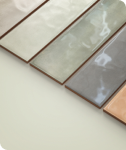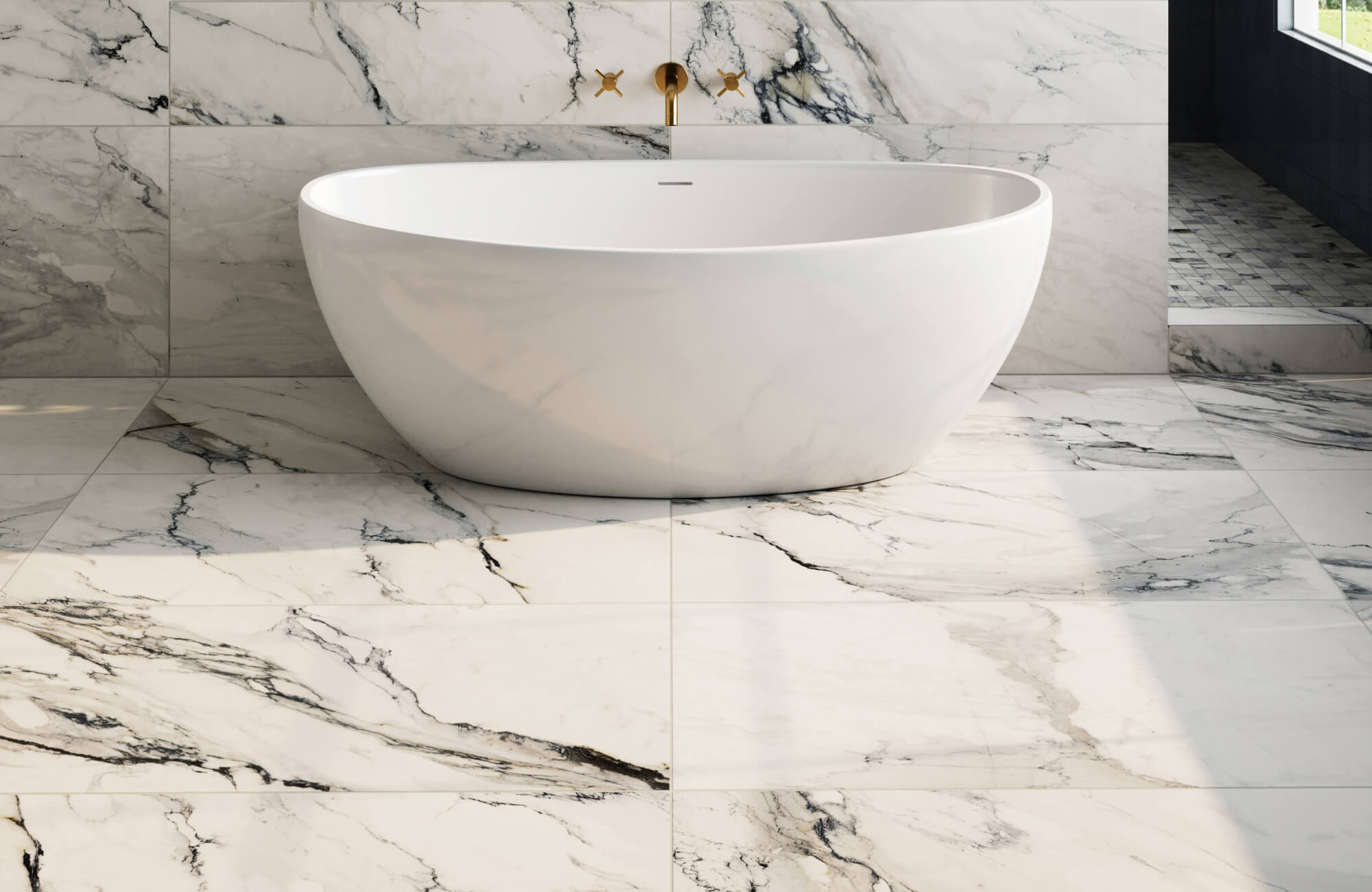Beige tiles, often associated with timeless elegance, have been a staple in traditional bathroom designs due to their versatility and ability to complement various styles. However, with modern trends favoring bold and experimental aesthetics, the role of beige in contemporary bathrooms has come into question. Despite this, beige remains a practical and sophisticated choice when used creatively to harmonize with modern design elements.
This article explores how beige tiles can be integrated into modern bathroom designs by focusing on key aspects such as color psychology, layout, lighting, and decor, offering practical tips to balance their classic charm with a fresh, contemporary appeal.

Beige's Impact on Mood and Perception
Beige tiles bring more than just visual appeal to a bathroom. Their subtle tones influence the room’s mood and atmosphere, offering opportunities to create spaces that are calming, nostalgic, or even luxurious, depending on the design approach.
The Calming Effect of Beige and Its Versatility
Beige evokes a natural sense of calm, making it an ideal choice for creating spaces designed to relax and unwind. Its connection to earthy tones, like sand and stone, brings a soothing and grounded feel that promotes tranquility. This makes beige particularly effective in bathrooms, where a serene environment is often a priority.
To enhance its calming effect, beige works beautifully alongside wooden accents and soft, natural textures. A bathroom featuring beige tiles, warm wooden shelving, and gentle, diffused lighting creates a sense of balance and restoration.
Beige as a Source of Comfort and Nostalgia
Beige often brings a sense of nostalgia. In a bathroom with vintage-inspired fixtures, such as a clawfoot tub or brass faucets, beige tiles on the floors or walls can enhance the room’s character without overwhelming the design. The result is a space that feels both welcoming and rooted in tradition.
In the photo above, the Riley 24x48 Matte Porcelain Tile in Striped Pattern Cream from Edward Martin is featured as the central wall, bringing texture and subtle depth to the design. The freestanding white bathtub stands out as a focal point, while the black fixtures provide a contemporary contrast. On the other hand, the taupe subway tiles on either side of the shower areas introduce a complementary neutral tone, creating a seamless transition between the central wall and surrounding elements. The black-framed glass enclosures further modernize the space, tying the entire design together.
This blend of colors, combined with vintage-inspired elements, strikes a balance between traditional charm and contemporary style. By layering these elements thoughtfully, the design showcases how beige tiles can connect past and present in a way that feels cohesive and inviting.
Creating a Spa-Like Atmosphere
A beige bathroom can also easily transform into a spa-like retreat. Large beige tiles, when combined with soft, indirect lighting, create an airy and soothing space. Adding touches like bamboo shelving or a teak bath mat can enhance their natural tones as well. This interplay between the neutral backdrop and organic materials fosters a sense of relaxation.
Small touches, such as a bundle of plush white towels neatly stacked near the sink or a diffuser emitting lavender, can elevate the experience further. These elements work together with beige tiles to create a retreat that feels luxurious yet understated.
To explore how beige tiles can impact your bathroom design, Edward Martin's augmented reality (AR) tool allows you to visualize different tile options in your space. This innovative tool helps you see how beige tiles interact with your existing design elements, lighting, and color schemes, giving you confidence in creating a bathroom that perfectly suits your style and mood.
Lighting and Layout: Enhancing Beige Tiles
The way a bathroom is lit and arranged significantly impacts how beige tiles are perceived. Thoughtful use of lighting and layout can enhance the subtle beauty of beige, making it an integral part of modern bathroom design.
The Power of Natural and Artificial Light
Natural light enhances beige tiles by highlighting their subtle tones and textures. When sunlight streams across the tiles, it accentuates their natural variations and warmth, making the room feel airy and bright. In spaces with large windows, like the one shown above, the beige tiles on both the walls and floors exude a soft elegance, complemented by the interplay of shadows from the natural light. This combination not only highlights the tiles' natural beauty but also makes the entire bathroom feel expansive and open.
For bathrooms with limited natural light, beige tiles still perform well under layered artificial lighting. Recessed ceiling lights provide even illumination across the space, ensuring every corner is well-lit. Wall sconces near mirrors or above the vanity can also add focused lighting, creating functional zones while maintaining a cohesive and balanced look. This thoughtful combination of natural and artificial lighting allows beige tiles to retain their charm and functionality in any setting.
Functional Layouts That Maximize Space
In small bathrooms, beige tiles can make the room appear larger. Large format tiles placed horizontally on walls reduce grout lines, creating a seamless appearance that expands the perception of space. A simple glass shower enclosure can maintain this openness, allowing the continuity of beige tiles to flow uninterrupted.
Alternatively, in larger bathrooms, beige tiles can be paired with complementary materials to enhance both functionality and design. For instance, combining beige walls with textured concrete look flooring introduces contrast while preserving a sense of openness. This approach helps define areas like the vanity or shower without disrupting the overall visual flow.

Finish and Tile Size
The finish and size of your beige tiles significantly influence the overall look and feel of your bathroom. A matte finish, featured in Edward Martin’s Kennedy 24x24 Matte Porcelain Tile in Sand (seen above), creates a soft, understated aesthetic that works well in modern and minimalist designs. These tiles provide a neutral, grounded feel, blending seamlessly with elements like white cabinetry or natural wood accents. Alternatively, glossy beige tiles are more reflective and can brighten a space, making them ideal for bathrooms that need enhanced lighting. In smaller spaces, glossy finishes combined with mirrors can create the illusion of more openness.
Tile size also plays a critical role in design. As previously highlighted, large tiles are excellent for reducing grout lines, resulting in a cleaner, more expansive look on your walls and floors. On the other hand, smaller mosaic-style tiles, like Leona 3x3 Matte Porcelain Hexagon Mosaic Tile in Marfil, add texture and interest to focal points such as a shower niche or backsplash. By balancing finish and size, beige tiles can elevate a bathroom’s design, offering both functionality and style.

Beige Tiles in Mixed-Material Bathrooms
Beige tiles are a versatile choice for mixed-material bathrooms, seamlessly blending with various textures and tones. Their neutral base allows other elements to stand out while maintaining a cohesive and balanced design. For instance, beige tiles can work alongside wood and metal accents to create a balanced, modern space.
Edward Martin’s Astrid 3x6 Polished Porcelain Mosaic Tile in Alabaster (shown in the photo above) demonstrates how beige tiles can elevate a mixed-material design. Its polished surface reflects light, adding brightness and a subtle texture to the room. Paired with a veined white marble look tub surround, this Astrid tile brings an understated elegance. Light wood flooring also complements the soft beige tones, while the black-framed glass enclosures and matte black fixtures add a contemporary edge. This combination of materials shows how beige tiles can unify diverse elements into a cohesive, stylish bathroom.
Modernizing Your Beige Bathroom
Modernizing a beige bathroom is about blending timeless elements with contemporary details to create a space that feels both refreshed and stylish. For example, as depicted in the photo above, you can pair beige hexagonal floor tiles with vertical blue wall tiles, introducing a modern contrast that remains harmonious and balanced. The soft tones of the beige tiles ground the space, while the vertical blue tiles add a sense of height and visual interest. A floating wood vanity with a subtle textured finish also adds warmth and depth, while brushed gold fixtures provide a touch of elegance without overwhelming the design. Adding organic details like a curved side table and fresh greenery softens the overall look, creating a bathroom that feels natural, welcoming, and perfectly contemporary.
A Balanced Approach
Ultimately, beige tiles offer a unique opportunity to bridge classic design and contemporary trends. With thoughtful consideration of lighting, texture, and complementary materials, they can transform a bathroom into a space that feels timeless yet modern. Whether used as a neutral backdrop for bold accents or paired with natural elements like wood and marble, beige tiles provide the flexibility to create a personalized and adaptable design.
To help you make the best choice for your space, Edward Martin offers high-quality 4" x 4" samples that accurately reflect the color and finish of all tile sizes within each collection. This ensures you can confidently evaluate the tiles' look and feel in your own home before making a decision, giving you complete assurance in selecting a tile that aligns with your vision.









